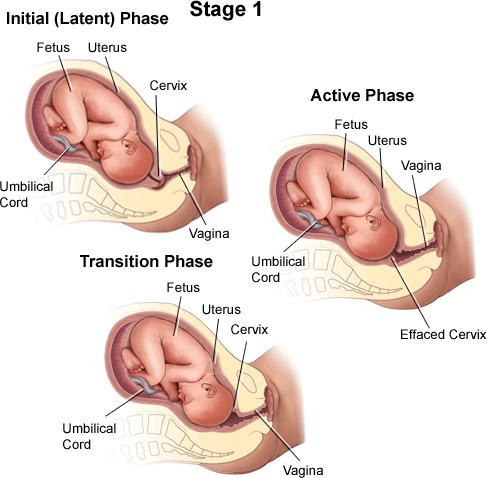A woman in her 40th week of pregnancy calls the nurse at the clinic and says she's not sure whether she is in true or false labor. Which statement by the client would lead the nurse to suspect that the woman is experiencing false labor?
Select one:
"If I try to talk to my partner during a contraction, I can't."
"My contractions slow down when I walk around."
"I feel contractions start mostly in my back and they sweep around to the top of my abdomen."
"My contractions are about 6 minutes apart and regular."
The Correct Answer is B
Choice A Reason: "If I try to talk to my partner during a contraction, I can't." This is an incorrect answer that indicates a sign of true labor, not false labor. True labor is a condition where there are regular and painful uterine contractions that cause cervical dilation and effacement, and lead to delivery of the baby and placenta. True labor contractions are usually strong and consistent, and they tend to increase or persist with activity or position changes. True labor contractions can be so intense that they interfere with speech or breathing.
Choice B Reason: ) "My contractions slow down when I walk around." This is because this statement by the client would lead the nurse to suspect that the woman is experiencing false labor, which is also known as Braxton Hicks contractions or practice contractions. False labor is a condition where there are irregular and painless uterine contractions that do not cause cervical dilation or effacement. False labor can occur throughout pregnancy, but it becomes more noticeable and frequent in late pregnancy. False labor contractions are usually weak and inconsistent, and they tend to decrease or stop with activity or position changes.
Choice C Reason: "I feel contractions start mostly in my back and they sweep around to the top of my abdomen." This is an incorrect answer that indicates a sign of true labor, not false labor. True labor contractions usually start in the lower back and radiate to the lower abdomen or groin, following a wave-like patern. False labor contractions are more likely to be felt in the upper abdomen or sides, without a clear patern.
Choice D Reason: "My contractions are about 6 minutes apart and regular." This is an incorrect answer that indicates a sign of true labor, not false labor. True labor contractions usually have a regular frequency and duration, and they become closer and longer as labor progresses. False labor contractions are more likely to have an irregular frequency and duration, and they do not change significantly over time.
Nursing Test Bank
Naxlex Comprehensive Predictor Exams
Related Questions
Correct Answer is C
Explanation
Choice A Reason: Continuing to monitor and document fetal heart rate. This is an inadequate response that does not address the urgency of the situation or intervene to prevent fetal distress or demise.
Choice B Reason: Changing the mother's position to left lateral and giving oxygen by nasal cannula. This is a partial response that may improve maternal-fetal blood flow and oxygenation, but it does not resolve the cord compression or facilitate delivery.
Choice C Reason: With a sterile glove, maintaining pressure to lift the presenting part and emergently notifying the provider for a STAT C-section. This is an appropriate response that aims to reduce the cord compression by elevating the fetal head away from the cord and prepare for an immediate cesarean delivery.
Choice D Reason: Bolusing the patient with 1000cc lactated ringers. This is an irrelevant response that does not address the cause of the problem or improve fetal outcome.
Correct Answer is A
Explanation
Choice A Reason: Latent phase of the first stage of labor. This is because this phase is characterized by mild and irregular contractions, slow cervical dilation (up to 4 cm), minimal cervical effacement (up to 40%), and minimal discomfort or pain. The latent phase is also known as the early phase or preparatory phase of labor.
Choice B Reason: Transition phase of the first stage of labor. This is an incorrect answer that describes a different phase with different characteristics. The transition phase is marked by strong and frequent contractions, rapid cervical dilation (from 8 to 10 cm), complete cervical effacement (100%), and intense discomfort or pain. The transition phase is also known as the terminal phase or acceleration phase of labor.
Choice C Reason: Perineal phase of the second stage of labor. This is an incorrect answer that refers to another stage and phase with different features. The second stage of labor begins with complete cervical dilation (10 cm) and ends with delivery of the baby. The perineal phase is the last part of the second stage, where the baby's head crowns and emerges through the vaginal opening.
Choice D Reason: Active phase of the first stage of labor. This is an incorrect answer that indicates another phase with different atributes. The active phase is characterized by moderate and regular contractions, progressive cervical dilation (from 4 to 8 cm), increased cervical effacement (from 40% to 80%), and increased discomfort or pain. The active phase is also known as the middle phase or dilatation phase of labor.

Whether you are a student looking to ace your exams or a practicing nurse seeking to enhance your expertise , our nursing education contents will empower you with the confidence and competence to make a difference in the lives of patients and become a respected leader in the healthcare field.
Visit Naxlex, invest in your future and unlock endless possibilities with our unparalleled nursing education contents today
Report Wrong Answer on the Current Question
Do you disagree with the answer? If yes, what is your expected answer? Explain.
Kindly be descriptive with the issue you are facing.
